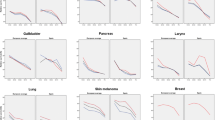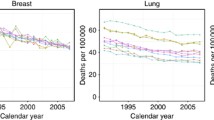Abstract
Reports of population-based survival rates of cancer from developing countries are infrequent. In Latin America, only the Cancer Registry of Puerto Rico has published population-based survival data. The National Cancer Registry of Cuba has achieved three survival studies with cases incident in 1976, 1982 and 1988–1989. This article deals with the global observed and relative survival rates estimated in the latter study. Survival time trends are analysed. In the period 1988–1989, 12,985 primary cancer cases were included from the most common cancer sites, with the exclusion of cancer in situ cases and 8900 cases reported by ‘death certificate only’ (DCO) (35.8%). The vital status of cases was checked up to 31 December 1994 using a mixed follow-up system with the exclusion of 2900 cases lost to follow-up (11.2%). DCO proportions are shown for the major sites and compared to those of 1982. Observed survival rates were estimated by Kaplan–Meier method using the SPSS Statistical Software. The relative rates were estimated by the Hakulinen's Computer Program Package for Cancer Survival Studies (1988) using life tables from Cuban population. Statistical comparisons of survival curves by year of diagnosis were achieved by using the Log–Rank and Pearson statistic tests. Global results are shown by year of follow-up and a comparative analysis is done in time and with internationals values. Survival rates decreased in the period 1982/1988–1989 for colon, prostate and lung cancer. Prostate cancer shows a low five years relative survival rate when compared with the USA, but its observed rate is comparable with Puerto Rico's. Figures for mouth and lung cancer were comparable with the corresponding figures of the USA and Europe. Breast and cervix cancers rates are comparable with the European mean and the blacks in USA.
Similar content being viewed by others
References
Annual statistics 1996. Cuba: National Statistics Direction, Health Ministry, 1997.
Parkin DM, Wagner G, Muir C, eds. IARC-The role of the cancer registry in cancer control. IARC Scientific Publications No. 66 Lyon: International Agency for Research on Cancer, 1985.
Jensen OM, Storm HH. Aims and uses of cancer registries. In: Jensen OM, Parkin DM, Mac Lennan R, Muir CS and Skeet RG (eds), Cancer registration. Principles and methods. IARC Scientific Publications No. 95. Lyon: International Agency for Research on Cancer, 1991: 7–23.
Navarro Sánchez C, Lizán García M, Tormo Díaz MJ. Uses of death certificates in population-based cancer registries. Gaceta Sanitaria 1988; 2(7): 197–202.
Rios Massabot E. Actual state of information in mortality systems in Cuba. Havana, Cuba: Health Development Institute, Health Ministry Report, 1980.
Rios Massabot E, Tejeiro Fernandez A, Mesa Machado AC. Quality of medical death certification. Havana, Cuba: Direction of National Statistics, Health Ministry Report, 1991.
Graupera M, Abascal ME, et al. Survival rates of cancer in Cuba, 1982. Revista Brasileira de Cancerologia 1994; 40(3): 135–140.
Central cancer registry of Puerto Rico — Cancer in Puerto Rico, 1987. Lybrary of Congress Cataloging in Publication Data, 1989.
Central cancer registry of Puerto Rico — Cancer in Puerto Rico, 1989. Lybrary of Congress Cataloging in Publication Data, 1991.
Fernández L, Graupera M, Galán Y, Lezcano M, Martín A, Camacho R. Cancer survival in Cuba. In: Sankaranarayanan R, Black R, Parkin DM (eds), Cancer survival in developing countries. IARC Scientific Publications No. 145. Lyon: International Agency for Research on Cancer, 1998: 51–59.
Parkin DM, Chen J, Ferlay J, Galcerán J, Storm HH, Whelan SL. Comparability and quality control in cancer registries. IARC Technical report No. 19. Lyon: International Agency for Research on Cancer, 1995: 79–83.
Estéve J, Benhamou E, Raymond L. Statistical method in cancer research. Volume 4. Descriptive Epidemiology. IARC Scientific Publications No. 128. Lyon: International Agency for Research on Cancer, 1994.
Hakulinen T, Abeywickrama KM. A computer program package for relative analysis. Computer Programs in Biomedicine 1985; 19: 197–207.
Berrino F, Sant M, Verdecchia A, Capocaccia R, Hakulinen T and Esteve J, eds. IARC — European Commission — Survival of cancer patients in Europe. The Eurocare study. IARC Scientific Publications No. 132 Lyon: International Agency for Research on Cancer, 1995.
WHO-IARC. Prostate. In: Coleman MP, Estéve J, Damiecki P, Arsland A, Renard H (eds), Trends in cancer incidence and mortality. Scientific Publications No. 121 Lyon: International Agency for Research on Cancer, 1993.
SEER (Surveillance, Epidemiology and End Results Program, National Cancer Institute, Division of Cancer Prevention and Control). 1987 Annual Cancer Statistics Review, Including Cancer trends 1950–95. Bethesda: US Department of Health and Human Services, No. 88–2789, 1988.
Post PN, Damhuis RAM, van der Meyden APM and the EUROCARE Working Group. Variation in survival of patients with prostate cancer in Europe since 1978. Eur J Cancer 1998; 34(14): 2226–2231.
Author information
Authors and Affiliations
Rights and permissions
About this article
Cite this article
Boschmonar, M.C.G., Chaviano, P.J.J., García, A.A.M. et al. Trends in survival rates of cancer in Cuba. Eur J Epidemiol 15, 521–528 (1999). https://doi.org/10.1023/A:1007587507460
Issue Date:
DOI: https://doi.org/10.1023/A:1007587507460




